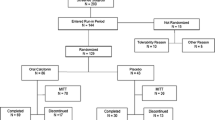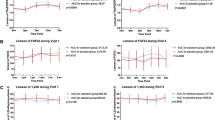Abstract
Annual bone loss rate was estimated in a group of randomly selected 150 nonsurgical and nonosteoporotic early postmenopausal women, 42–56 years, with the use of the mathematical equation proposed by Christiansen et al. (OSTEOTREND-R) [1]. Fifty-six women were characterized as high turnover patients (estimated annual bone loss more than 2.7%). These high turnover patients were included in a double-blind, placebo-controlled clinical study. Patients were divided into two groups of 28 women each. The first group of patients received 100 IU of salmon calcitonin intranasally daily for 1 year and the second group intranasal spray of placebo daily. Blood and urine biochemical parameters as well as bone mineral content of the spine and proximal forearm were determined initially and at the end of 6 and 12 months. No other side effects were noted apart from discomfort of nasal mucosa in two patients (one in each group). The group of calcitonin-treated patients showed a dramatic decrease in bone loss rate as estimated with the use of biochemical bone markers at the end of 6 and 12 months (3.7% versus 0.8% and 0.0% at the end of 6 and 12 months, respectively, P<0.001) whereas in the placebo group, bone loss rate remained unchanged (4.2% versus 4.1% and 4.3% at the end of 6 and 12 months, respectively). The calcitonintreated patients showed a significant increase in bone mineral content of spine and proximal forearm (P<0.001 at the end of 6 and 12 months, respectively). On the other hand, a significant decrease in all measurement sites appeared in the placebo group. In conclusion, our results showed that nasal salmon calcitonin administration can prevent the increased postmenorpausal bone loss in selected high bone turnover patients. The predicted annual bone loss rate, as estimated with the combination of biochemical bone markers, is useful in monitoring the responsiveness of high turnover patients to calcitonin at short intervals.
Similar content being viewed by others
References
Christiansen C, Riis BJ, Rodbro P (1987) Prediction of rapid bone loss in postmenopausal women. Lancet i:1105–1108
Christiansen C, Riis BJ, Rodbro P (1990) Screening procedure for women at risk of developing postmenopausal osteoporosis. Osteoporosis. Int 1:35–40
Whyte MP, Bergfeld MA, Murphy WA, Avioli LV, Teitlbaum SL (1982) Postmenopausal osteoporosis: a heterogeneous disorder as assessed by histomorphometric analysis of iliac crest bone from treated patients. Am J Med 72:193–202
Riggs BL, Melton J III (1986) Involutional osteoporosis. N Engl J Med 314:1676–1686
Reginster JY, Albert A, Lecart MP, et al (1987) 1-year controlled randomised trial of prevention of early postmenopausal bone loss by intranasal salmon calcitonin. Lancet ii:1481–1483
Overgaard K, Riis BJ, Christiansen C, Hansen MA (1989) Effect of salcalcitonin given intranasally on early postmenopausal bone loss. Br Med J 299:477–479
Civitelli R, Gonelli S, Zacchei F, Bigazz S, Vattimo A, Avioli LV, Gennari C (1988) Bone turnover in postmenopausal osteoporosis. Effect of calcitonin treatment. J Clin Invest 82:1268–1274
Christiansen C (1987) Selection of postmenopausal women for estrogen therapy. In: Christiansen C, Johansen J, Riis BJ (eds) Osteoporosis 1987. Proceedings of the International Symposium on Osteoporosis, Copenhagen, Denmark. Osteopress Aps pp 533–538
Gennari C, Agnusdei D, Gonelli S, et al (1989) Pharmacodynamic tests for evaluation of biological efficacy of synthetic salmon calcitonin nasal spray. In: Mazzuoli GF (ed) New therapeutic perspectives: the nasal spray. Basle, pp 48–65
Gindler EM, King GT (1972) Pathogenesis of idiopathic hypercalciuria. Am J Clin Pathol 58:376–382
LeRoy AC (1976) The techniques and significance of hydroxyproline measurement in man. In: Bodansky O, Stewart CP (eds) Advances in clinical chemistry. Academic Press Inc, p 213
Overgaard K, Hansen MA, Herss Nielsen VA et al (1990) Discontinuous calcitonin treatment of established osteoporosis-effects of withdrawal of treatment. Am J Med 89:1–6
Delmas PD (1993) Biological markers of bone turnover in osteoporosis. In: Christiansen C (ed) Proc 4th Symp on Osteoporosis. Hong Kong, pp 46–49
Dresner-Pollak R, Rosen HN, Maitland LA, et al (1993) Femoral bone density changes correlate with biochemical markers of bone turnover in the elderly (abstract). J Bone Miner Res 8 (suppl 1) 925
Mazzuoli GF, Passeri M, Gennari C, Minisola S, Antonelli R, Veltora C, Palummeri E, Cervellin GF, Gonelli S, Francini G (1986) Effects of salmon calcitonin in postmenopausal osteoporosis: a controlled double-blind clinical study. Calcif Tissue Int 38:3–8
Chestnut Ch III, Baylink DJ, Gruber HE, Ivey JL, Methews M, Sison K, Nelp WB (1981) Treatment of postmenopausal osteoporosis with salmon caicitonin: preliminary results. In: DeLuca HF, Frost HM, Jee WSS, Johnston CC Jr, Parfirt AM (eds) Osteoporosis. University Park Press, Baltimore, pp 411–418
Wallach S, Farley JR, Baylink DJ, Brenner-Gati L (1993) Effects of calcitonin on bone quality and osteoblastic function. Calcif Tissue Int 52:335–339
Author information
Authors and Affiliations
Rights and permissions
About this article
Cite this article
Lyritis, G.P., Magiasis, B. & Tsakalakos, N. Prevention of bone loss in early nonsurgical and nonosteoporotic high turnover patients with salmon calcitonin: The role of biochemical bone markers in monitoring high turnover patients under calcitonin treatment. Calcif Tissue Int 56, 38–41 (1995). https://doi.org/10.1007/BF00298742
Received:
Accepted:
Issue Date:
DOI: https://doi.org/10.1007/BF00298742




